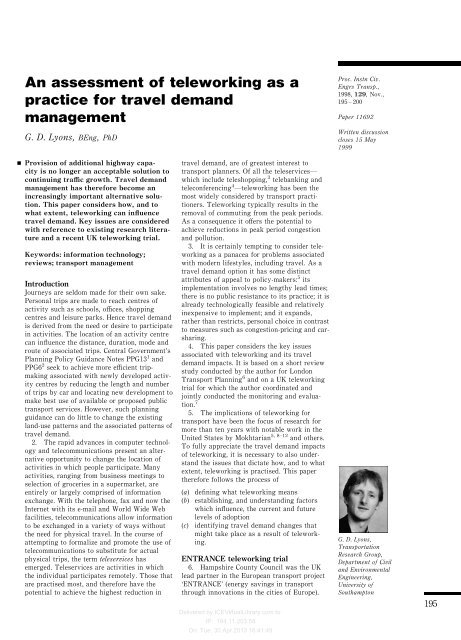Lyons, G. (1998) An assessment of teleworking as a practice for ...
Lyons, G. (1998) An assessment of teleworking as a practice for ...
Lyons, G. (1998) An assessment of teleworking as a practice for ...
You also want an ePaper? Increase the reach of your titles
YUMPU automatically turns print PDFs into web optimized ePapers that Google loves.
<strong>An</strong> <strong><strong>as</strong>sessment</strong> <strong>of</strong> <strong>teleworking</strong> <strong>as</strong> a<br />
<strong>practice</strong> <strong>for</strong> travel demand<br />
management<br />
G. D. <strong>Lyons</strong>, BEng, PhD<br />
Proc. Instn Civ.<br />
Engrs Transp.,<br />
<strong>1998</strong>, 129, Nov.,<br />
195 ± 200<br />
Paper 11692<br />
Written discussion<br />
closes 15 May<br />
1999<br />
&<br />
Provision <strong>of</strong> additional highway capacity<br />
is no longer an acceptable solution to<br />
continuing trac growth. Travel demand<br />
management h<strong>as</strong> there<strong>for</strong>e become an<br />
incre<strong>as</strong>ingly important alternative solution.<br />
This paper considers how, and to<br />
what extent, <strong>teleworking</strong> can in¯uence<br />
travel demand. Key issues are considered<br />
with reference to existing research literature<br />
and a recent UK <strong>teleworking</strong> trial.<br />
Keywords: in<strong>for</strong>mation technology;<br />
reviews; transport management<br />
Introduction<br />
Journeys are seldom made <strong>for</strong> their own sake.<br />
Personal trips are made to reach centres <strong>of</strong><br />
activity such <strong>as</strong> schools, oces, shopping<br />
centres and leisure parks. Hence travel demand<br />
is derived from the need or desire to participate<br />
in activities. The location <strong>of</strong> an activity centre<br />
can in¯uence the distance, duration, mode and<br />
route <strong>of</strong> <strong>as</strong>sociated trips. Central Government's<br />
Planning Policy Guidance Notes PPG13 1 and<br />
PPG6 2 seek to achieve more ecient tripmaking<br />
<strong>as</strong>sociated with newly developed activity<br />
centres by reducing the length and number<br />
<strong>of</strong> trips by car and locating new development to<br />
make best use <strong>of</strong> available or proposed public<br />
transport services. However, such planning<br />
guidance can do little to change the existing<br />
land-use patterns and the <strong>as</strong>sociated patterns <strong>of</strong><br />
travel demand.<br />
2. The rapid advances in computer technology<br />
and telecommunications present an alternative<br />
opportunity to change the location <strong>of</strong><br />
activities in which people participate. Many<br />
activities, ranging from business meetings to<br />
selection <strong>of</strong> groceries in a supermarket, are<br />
entirely or largely comprised <strong>of</strong> in<strong>for</strong>mation<br />
exchange. With the telephone, fax and now the<br />
Internet with its e-mail and World Wide Web<br />
facilities, telecommunications allow in<strong>for</strong>mation<br />
to be exchanged in a variety <strong>of</strong> ways without<br />
the need <strong>for</strong> physical travel. In the course <strong>of</strong><br />
attempting to <strong>for</strong>malize and promote the use <strong>of</strong><br />
telecommunications to substitute <strong>for</strong> actual<br />
physical trips, the term teleservices h<strong>as</strong><br />
emerged. Teleservices are activities in which<br />
the individual participates remotely. Those that<br />
are practised most, and there<strong>for</strong>e have the<br />
potential to achieve the highest reduction in<br />
travel demand, are <strong>of</strong> greatest interest to<br />
transport planners. Of all the teleservicesÐ<br />
which include teleshopping, 3 telebanking and<br />
teleconferencing 4 Ð<strong>teleworking</strong> h<strong>as</strong> been the<br />
most widely considered by transport practitioners.<br />
Teleworking typically results in the<br />
removal <strong>of</strong> commuting from the peak periods.<br />
As a consequence it o€ers the potential to<br />
achieve reductions in peak period congestion<br />
and pollution.<br />
3. It is certainly tempting to consider <strong>teleworking</strong><br />
<strong>as</strong> a panacea <strong>for</strong> problems <strong>as</strong>sociated<br />
with modern lifestyles, including travel. As a<br />
travel demand option it h<strong>as</strong> some distinct<br />
attributes <strong>of</strong> appeal to policy-makers: 5 its<br />
implementation involves no lengthy lead times;<br />
there is no public resistance to its <strong>practice</strong>; it is<br />
already technologically fe<strong>as</strong>ible and relatively<br />
inexpensive to implement; and it expands,<br />
rather than restricts, personal choice in contr<strong>as</strong>t<br />
to me<strong>as</strong>ures such <strong>as</strong> congestion-pricing and carsharing.<br />
4. This paper considers the key issues<br />
<strong>as</strong>sociated with <strong>teleworking</strong> and its travel<br />
demand impacts. It is b<strong>as</strong>ed on a short review<br />
study conducted by the author <strong>for</strong> London<br />
Transport Planning 6 and on a UK <strong>teleworking</strong><br />
trial <strong>for</strong> which the author coordinated and<br />
jointly conducted the monitoring and evaluation.<br />
7<br />
5. The implications <strong>of</strong> <strong>teleworking</strong> <strong>for</strong><br />
transport have been the focus <strong>of</strong> research <strong>for</strong><br />
more than ten years with notable work in the<br />
United States by Mokhtarian 5, 8±12 and others.<br />
To fully appreciate the travel demand impacts<br />
<strong>of</strong> <strong>teleworking</strong>, it is necessary to also understand<br />
the issues that dictate how, and to what<br />
extent, <strong>teleworking</strong> is practised. This paper<br />
there<strong>for</strong>e follows the process <strong>of</strong><br />
(a) de®ning what <strong>teleworking</strong> means<br />
(b) establishing, and understanding factors<br />
which in¯uence, the current and future<br />
levels <strong>of</strong> adoption<br />
(c) identifying travel demand changes that<br />
might take place <strong>as</strong> a result <strong>of</strong> <strong>teleworking</strong>.<br />
ENTRANCE <strong>teleworking</strong> trial<br />
6. Hampshire County Council w<strong>as</strong> the UK<br />
lead partner in the European transport project<br />
`ENTRANCE' (energy savings in transport<br />
through innovations in the cities <strong>of</strong> Europe).<br />
Delivered by ICEVirtualLibrary.com to:<br />
IP: 164.11.203.58<br />
On: Tue, 30 Apr 2013 16:41:49<br />
G. D. <strong>Lyons</strong>,<br />
Transportation<br />
Research Group,<br />
Department <strong>of</strong> Civil<br />
and Environmental<br />
Engineering,<br />
University <strong>of</strong><br />
Southampton<br />
195
















